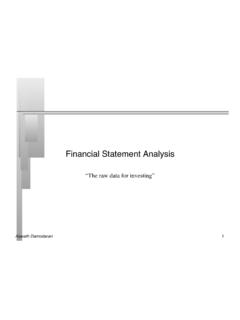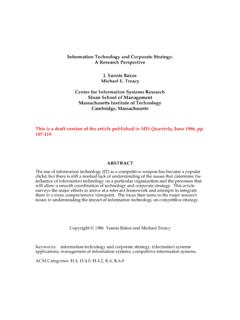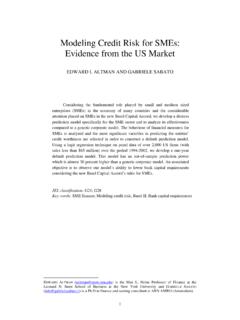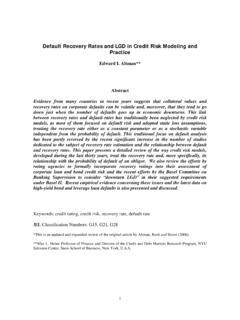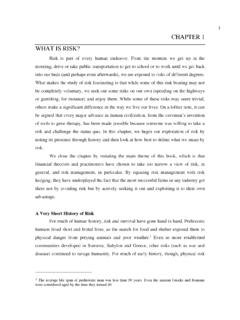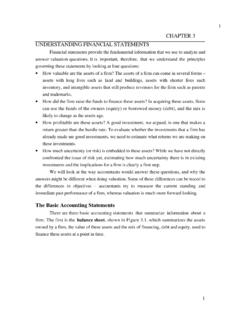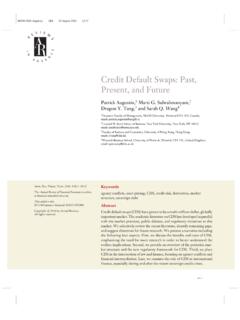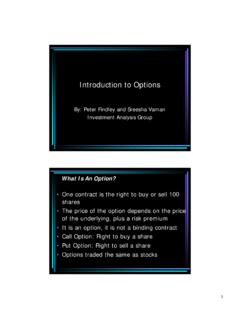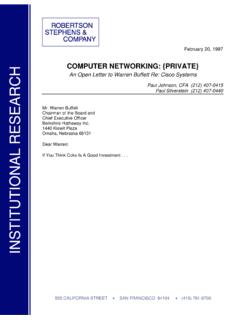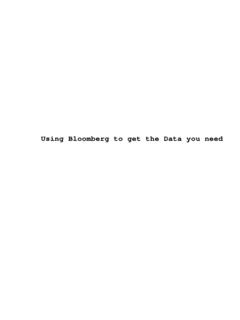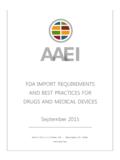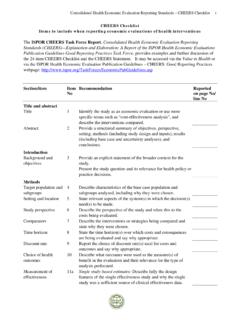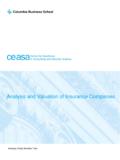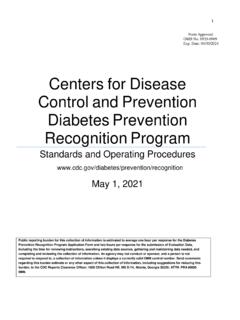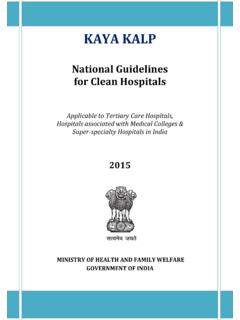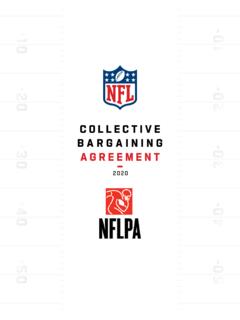Transcription of The Value of Intangibles
1 Aswath Damodaran1 The Value of IntangiblesAswath DamodaranAswath Damodaran2 Start with the Intangible assets are worth a lot and accountants don t do a good job in assessing their Value Leonard Nakamura of the Federal Reserve Bank of Philadelphia provided three different measures of the magnitude of intangible assets in today s economy an accounting estimate of the Value of the investments in R&D, software, brand development and other Intangibles ; the wages and salaries paid to the researchers, technicians and other creative workers who generate these intangible assets; and the improvement in operating margins that he attributes to improvements to intangible factors. With all three approaches, he estimated the investments in intangible assets to be in excess of $ 1 trillion in 2000 and the capitalized Value of these intangible assets to be in excess of $ 6 trillion in the same year.
2 Baruch Lev has argued persuasively that the way in which accountants deal with Intangibles is neither conservative nor informative. Expensing R&D, for instance, does understate earnings for high growth companies but it overstates earnings for low growth firms. In a paper with Paul Zarowin, he presents evidence that earnings at firms have become less correlated with stock prices and he attributes this phenomenon to the failure to accounting for intangible Damodaran3So, what are intangible assets? The loosest and broadest definition of an intangible asset is that it is an asset that we can neither see nor feel. Using that definition, though, we can come up with a broad range of intangible assets including: Franchises, copyrights and trademarks Patents Brand names To this list, we can add on what we consider the invisible assets including Top-notch management Loyal and well-trained workforce Technological know-howAswath Damodaran4 And do we do them justice in valuation ?
3 Critics of valuation analysts, in particular, and quantitative valuation models, in general, argue that we miss intangible assets because we are so focused on the bottom line - earnings and cash flows. Implicit in this criticism is the belief that if accountants do not show intangible assets on the balance sheet, we will miss these assets when we are doing Damodaran5 The Solutions offered by Critics Premium approach: Add a premium to the values that we arrive at for companies with substantial intangible assets. The magnitude of the premium is usually subjective and left to the analyst to estimate for individual companies. Book Value approach: Force accountants to come up with reasonable values for intangible assets and show them as assets on the balance sheet. Aswath Damodaran6 Dangers of Ad-hoc approaches Double counting: For assets that already generate a portion of the earnings and the cash flows, adding a premium on to the Value will be double counting Value .
4 Rules of thumb: Even when we are not double counting, there is a danger with using subjective rules of thumb to estimate the Value of uncounted assets. For instance, technological prowess cannot add 20% to the Value of a company. It has to be valued in each case, and may we worth 5% sometimes and 50% at other Damodaran7 Categorizing Intangibles Independent and Cash flow generating Intangibles Not independent and cash flow generating to the firm No cash flows now but potential for cashflows in future Examples Copyrights, trademarks, licenses, franchises, professional practices ( medical , dental) Brand names, Quality and Morale of work force, Technological expertise, Corporate reputation Undeveloped patents, operating or financial flexibility (to expand into new products/markets or abandon existing ones) valuation approach Estimate expected cashflows from the product or service and discount back at appropriate discount rate.
5 Compare DCF Value of firm with intangible with firm without (if you can find one) Assume that all excess returns of firm are due to intangible. Compare multiples at which firm trades to sector averages. Option valuation Value the undeveloped patent as an option to develop the underlying product. Value expansion options as call options Value abandonment options as put options. Challenges Life is usually finite and terminal Value may be small. Cashflows and Value may be person dependent (for professional practices ) With multiple Intangibles (brand name and reputation for service), it becomes difficult to break down individual components. Need exclusivity. Difficult to replicate and arbitrage (making option pricing models dicey) Aswath Damodaran8I. Valuing independent and cash flow producing intangible assets: Valuing a copyright Assume that John Wiley has been approached by another publisher who is interested in buying the copyright to this book (Damodaran on valuation ).
6 To estimate the Value of the copyright, we will make the following assumption. The book is expected to generate $150,000 in after-tax cash flows for the next three years and $100,000 a year for the following two years. These are the cash flows after author royalties, promotional expenses and production costs. About 40% of these cash flows are from large organizations that make bulk orders and are considered predictable and stable. The cost of capital applied to these cash flows is 7%. The remaining 60% of the cash flows are to the general public and this segment of the cash flows is considered much more volatile. The cost of capital applied to these cash flows is 10%.Aswath Damodaran9 Valuing Damodaran on ValuationYear Stable Cashflows Present Value @ 7% Volatile Cashflows Present Value @ 10% 1 $60,000 $56,075 $90,000 $81,818 2 $60,000 $52,406 $90,000 $74,380 3 $60,000 $48,978 $90,000 $67,618 4 $40,000 $30,516 $60,000 $40,981 5 $40,000 $28,519 $60,000 $37,255 $216,494 $302,053 Aswath Damodaran10 Franchise Value Brand Name Value : The franchise might have a brand name Value that enables the franchisee to charge higher prices and attract more customers than an otherwise similar business.
7 Thus, an investor may be willing to pay a significant up-front fee to acquire a McDonald s franchise, in order to take advantage of the brand name Value associated with the company. This brand name Value is augmented by the fact that the franchisor often provides the advertising for the product. Product/Service Expertise: In some cases, a franchise has Value because the franchisor provides expertise on the product or service that is being sold. For instance, a McDonald s franchisee will have access to the standard equipment that McDonald s uses as well as the product ingredients (the special sauce on the Big Mac). Legal Monopolies: Sometimes, a franchise may have Value because the franchisee is given the exclusive right to provide a service.
8 For instance, a company may pay a large fee for the right to operate concession stands in a baseball stadium, knowing that they will face no competition within the stadium. In a milder variant of this, multiple franchises are sometimes sold but the number of franchises is kept limited to insure that the franchisees earn excess returns. New York City, for example, sells cab medallions that are a pre-requisite for operating a yellow cab in the city. They also have tight restrictions on non-medallion owners offering the same service. Consequently, a market where cab medallions are bought and sold exists. Aswath Damodaran11 Businesses with personal components Some businesses have a personal component to them, and their Value can be linked to this personal component.
9 A doctor s practice or a highly rated restaurant are good examples. While these businesses may be very profitable, a significant portion of the profits may be attributed to the person running the business (the doctor or the chef). When paying for these businesses, you will have to Value them on the assumption that this key person will leave after the sale. The resulting lower Value will create a key person discount. This may allow for a negotiation process where the key person agrees to stay on to allow for a transition Damodaran12II. Firm-wide intangible assets- Ways of valuing Capital Invested: We can estimate the book Value of an asset by looking at what a firm has invested in that asset over time. With brand name, for instance, this would require looking at advertising expenditures over time, capitalizing these expenses and looking at the balance that remains unamortized of these expenses today.
10 Discounted Cash Flow valuation : We can discount the expected incremental cash flows generated by the intangible asset in question to the firm. This will require separating out the portion of the aggregate cash flows of a firm that can be attributed to brand name or technological expertise and discounting back these cash flows at a reasonable discount rate. Relative valuation : One way to isolate the effect of an intangible asset such as brand name is compare how the market values the firm (with the intangible) with how it values otherwise similar companies without the intangible asset. The difference can be attributed to the intangible asset. Aswath Damodaran13a. Valuing Coca Cola s brand name: Capital Invested approachYear Total Selling and Advertising Brand Name Related Expense Amortization this year Unamortized Expense 1980 $1,121 $561 $ $ 1981 $1,189 $594 $ $ 1982 $1,221 $610 $ $ 1983 $1,376 $688 $ $ 1984 $1,543 $771 $ $ 1985 $1,579 $789 $ $ 1986 $1,631 $815 $ $ 1987 $1,777 $888 $ $ 1988 $2,025 $1,013 $ $ 1989 $2,232 $1,116 $ $ 1990 $2,717 $1,359 $ $ 1991 $3,069 $1,535 $ $ 1992 $3,499 $1,750 $ $ 1993 $3,797 $1,898 $ $ 1994 $4,198 $2,099 $ $1, 1995 $4,657 $2,329 $ $1, 1996 $5,347 $2,673 $ $1, 1997 $5,235 $2,617 $ $1, 1998 $5,523 $2,761 $ $1, 1999 $6,543 $3,271 $ $2, 2000 $5,701 $2,850 $ $2, 2001 $4,099 $2,050 $ $1, 2002 $4,667 $2,334 $ $2, 2003 $4,992 $2,496 $ $2, 2004 $5,431 $2,715 $ $2, $1, $26.
